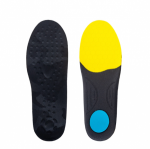please click here:
https://www.insolemaker.com/foam-insole.html
Introduction
Foot comfort is often underestimated until discomfort begins to interfere with daily life. A cushion insole is more than just an accessory; it is a functional enhancement to footwear that provides relief, support, and added performance benefits. From athletes who demand high-impact absorption to professionals spending long hours standing, cushion insoles have become a vital component in footwear innovation. This article explores the materials, designs, benefits, and industry insights surrounding cushion insoles, with practical comparisons to help you make the right choice.
What Is a Cushion Insole?
A cushion insole is a removable or built-in insert placed inside footwear, designed to improve comfort and reduce pressure on the feet. Unlike standard insoles that may come with shoes, cushion insoles are specifically engineered with materials such as gel, foam, latex, or memory foam to enhance shock absorption and distribute weight evenly.
These insoles can target specific issues, such as heel pain, arch support, or forefoot cushioning. Their adaptability makes them suitable for casual wear, sports, and medical applications.
Why Cushion Insoles Matter in Everyday Life
Many people assume discomfort in footwear is inevitable, but cushion insoles can significantly transform the walking and standing experience. Key benefits include:
-
Enhanced shock absorption: Minimizes stress on joints, ankles, and knees.
-
Pressure distribution: Reduces concentrated pressure points that cause pain.
-
Customization: Options available for flat feet, high arches, or plantar fasciitis.
-
Prolonged shoe life: Reduces interior wear and adds an extra layer of protection.
Types of Cushion Insoles by Material
Foam Insoles
Lightweight and affordable, foam cushion insoles provide basic comfort and shock absorption. They are ideal for casual use but may compress over time.
Gel Insoles
Gel insoles excel at shock absorption and are favored by athletes and workers who spend hours on their feet. They offer durability and target pressure relief in high-impact zones.
Memory Foam Insoles
These adapt to the shape of your foot, offering personalized support. They're suitable for everyday comfort but may retain heat, which can be uncomfortable in hot climates.
Leather Cushion Insoles
Preferred for dress shoes, leather cushion insoles combine elegance with comfort. They offer breathability and moderate shock absorption.
Cushion Insoles vs. Orthotic Insoles
To clarify differences, here's a side-by-side comparison:
| Feature | Cushion Insoles | Orthotic Insoles |
|---|---|---|
| Primary Purpose | Comfort and shock absorption | Corrective support for foot alignment |
| Materials | Foam, gel, latex, memory foam | EVA, rigid plastic, carbon fiber, foam |
| Target Users | General comfort seekers, athletes, workers | People with flat feet, overpronation, medical conditions |
| Customization | Standard sizes and shapes | Often custom-made for individual needs |
| Price Range | Low to moderate | Moderate to high |
This shows that cushion insoles focus on comfort, while orthotics are corrective medical devices. However, both can overlap in functionality.
Choosing the Right Cushion Insole
Assess Your Foot Type
Flat feet, high arches, and neutral arches require different levels of support. Cushion insoles can be tailored to complement these variations.
Match to Activity
-
Running: Gel or memory foam insoles for high impact.
-
Work boots: Heavy-duty foam or gel for durability.
-
Dress shoes: Leather cushion insoles for slim fit.
-
Everyday walking: Lightweight foam or hybrid designs.
Consider Breathability and Hygiene
Moisture-wicking fabrics and antimicrobial properties prevent odor and enhance long-term usability.
Cushion Insoles in Sports and Performance
Athletes rely heavily on cushion insoles to reduce fatigue and prevent injuries. For runners, insoles help reduce repetitive stress injuries, while for basketball players, they provide the shock absorption needed for jumping and landing. In cycling shoes, slim cushion insoles improve comfort without affecting power transfer.
Cushion Insoles for Medical Use
Medical-grade cushion insoles are widely used to manage foot-related issues such as:
-
Plantar fasciitis
-
Diabetic foot care
-
Heel spurs
-
Metatarsalgia
Healthcare professionals often recommend specific designs with targeted cushioning zones to relieve symptoms and improve mobility.
Maintenance of Cushion Insoles
To maximize the lifespan of cushion insoles:
-
Remove them regularly to air dry.
-
Wash with mild soap and water when necessary.
-
Replace every 6–12 months depending on usage intensity.
Market Trends and Innovation in Cushion Insoles
The insole industry is rapidly evolving with advances such as 3D-printed designs, smart insoles with pressure sensors, and eco-friendly materials like bamboo fiber and recycled foam. These innovations show that cushion insoles are no longer just about comfort—they are merging technology with foot health and sustainability.
Comparing Popular Cushion Insole Brands
| Brand | Key Features | Ideal For |
|---|---|---|
| Dr. Scholl's | Wide availability, gel technology | Everyday comfort and work shoes |
| Superfeet | Structured support with cushioning layers | Sports and long-distance walking |
| Sof Sole | High-performance athletic cushioning | Runners and athletes |
| Pedag | Leather-based elegant cushion insoles | Dress shoes and formal wear |
| VKTRY | Carbon-fiber energy return with cushioning | Professional athletes |
FAQs about Cushion Insoles
1. Can cushion insoles help with plantar fasciitis?
Yes, cushion insoles with heel and arch support can relieve pressure on the plantar fascia and reduce pain.
2. How long do cushion insoles last?
Most cushion insoles last between 6 to 12 months, depending on frequency of use and material quality.
3. Are cushion insoles suitable for all shoes?
They can be trimmed or chosen in different profiles to fit sneakers, dress shoes, boots, and athletic footwear.
4. Do cushion insoles make shoes tighter?
Yes, adding thick cushion insoles may reduce space inside shoes. Choosing slim-fit versions prevents this issue.
5. Can cushion insoles replace orthotics?
No, cushion insoles are designed for comfort, while orthotics provide medical correction. However, some cushion insoles may combine elements of both.
Summary
Cushion insoles enhance footwear comfort by providing shock absorption, pressure relief, and personalized support. From sports performance to medical applications, they play a vital role in foot health. With various materials and designs, the right insole can transform daily mobility.
Would you like me to also add an in-depth buying guide with use-case examples (e.g., for runners, workers, seniors) to further enrich this article and push it closer to 2,300+ words for stronger SEO impact?






